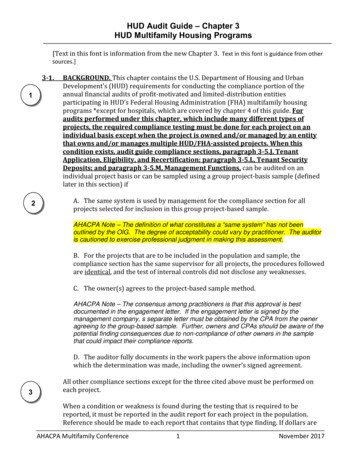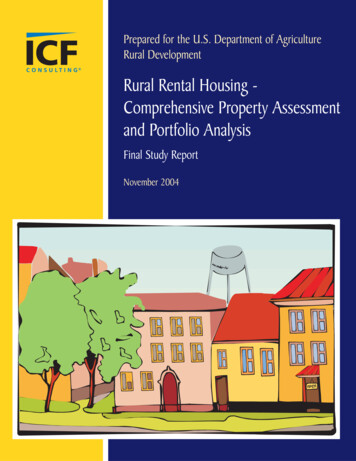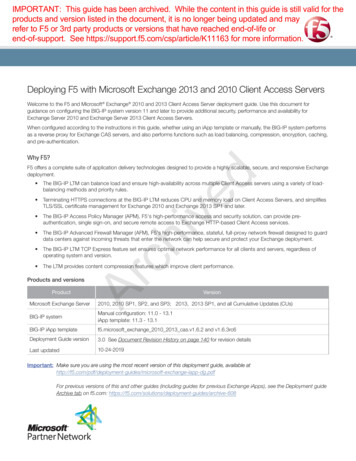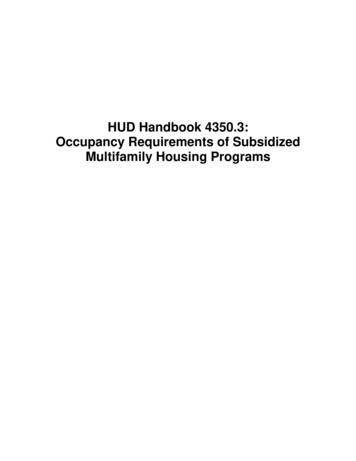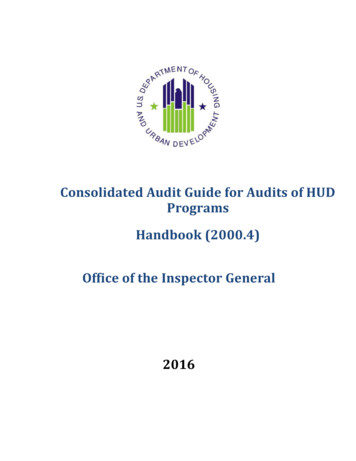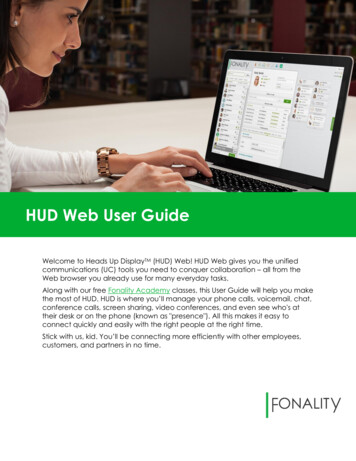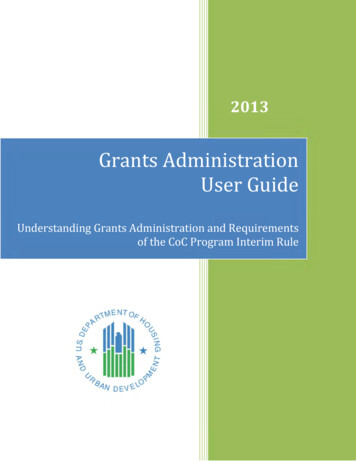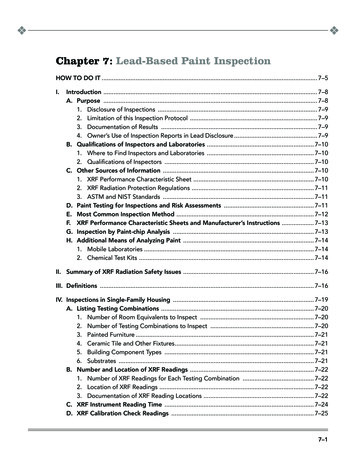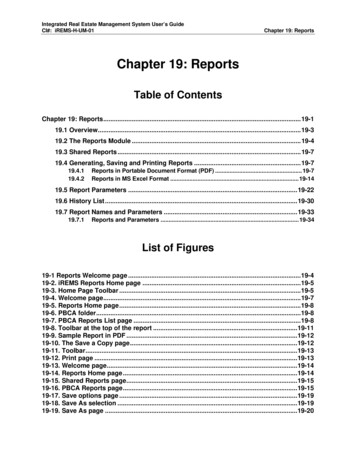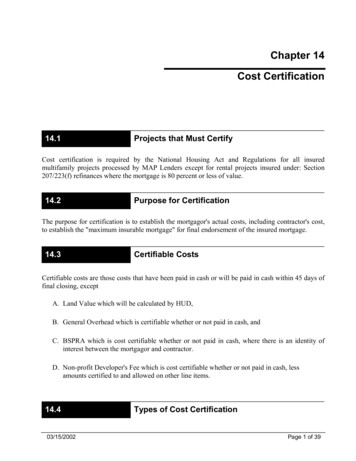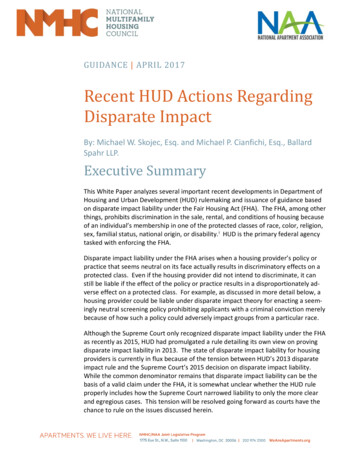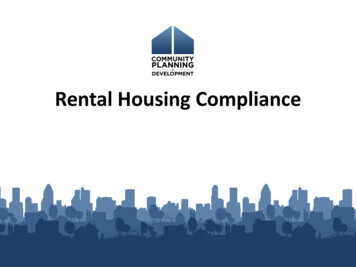
Transcription
Rental Housing Compliance
Agenda Review of HOME Requirements impacting unitmix Written Agreements and Deed Restrictions Income Limits and Income Determinations HOME Rents and Utilities Maintaining Affordability and Unit Mix Marketing and Tenant Relations Unit Quality and Inspections MonitoringSlide 2
Program Rule HOME requirements related to beneficiaries:– All assisted households at or below 80% AMI– Eligibility is determined at initial occupancy andrecertified on an annual basis 90% of HOME rental and TBRA householdsmust have incomes at/below 60% of AMI atinitial rent up of propertySlide 3
Project Rule Projects with 5 or more HOME-assisted units:– At least 20% of units must occupied byhouseholds at/below 50% of AMI [Note: can havemore than 20%!]– Determination of appropriate unit type is basedon gross income of household– Rents must be at low HOME rent level– Balance of units may be at/below 80% of AMI withhigh HOME rent levelSlide 4
Rental Occupancy Deadline HOME units must be occupied by income-eligibletenants within 18 months of project completion Critical for owner to report initial occupancy ofHOME units to PJ and PJ to enter data into IDIS todocument compliance HUD will track HOME units not occupied within 6months – PJ to provide strategy to meet deadline PJ must repay HOME investment for units notoccupied within 18 month termSlide 5
Written AgreementsSlide 6
Written Agreement Provides the final version of the HOME andproject specific requirements that will applythroughout the affordability period; Serves as the go to reference for owners,property managers, and PJ compliance staff; Any changes to the terms of the originalwritten agreement must be amended thru thecompletion of an amendment which mayrequire re-underwriting and cost allocation.Slide 7
Written Agreement and RentalCompliance Number and type of HOME assisted units– Bedroom distribution– Low HOME/ High HOME– Fixed or floating– Rent limits Affordability periodAffirmative marketingDefinition of incomeEnforcement provisionSlide 8
Written Agreement and RentalCompliance (cont) Income certification– Annual certification– Verification– Over income Lease requirementsProperty standardsAccess to files & units: PJ, HUD, IGReports (annual)RecordkeepingSlide 9
Optional Written AgreementContents Approval of sale or transfer including approvalof transfer of CHDO control Default provisions – noncompliance Budget review & financial reports Optional monitoring & intervention rights:– Reserves contributions/ disbursement approvals– Change in management/ownership– Access to CPA/auditorSlide 10
HOME Units and Affordability Period Number of HOME-assisted units described in thewritten agreement– All units HOME-assisted, or– Some units determined to be HOME-assistedthrough a cost allocation process Affordability period based on HOME investment perunit Above minimum # units required PJ’s discretion Project must maintain unit mix thru affordabilityperiodSlide 11
Affordability & ComplianceHOME ActivityRental housingacquisition and/orrehabilitationHOME Investment Length ofCompliance/AffordabilityPer UnitperiodLess than 15,0005 years 15,000 - 40,00010 yearsMore than 40,00015 yearsNew construction ofrental housingAny 20 yearsRefinancing of rentalhousingAny 15 years* Pay-off of the HOME assistance does not end theaffordability periodSlide 12
Designate Fixed or Floating Units Only units receiving HOME are subject toHOME requirements For properties with HOME and non-HOME units,must select “fixed” or “floating” HOME units– Fixed HOME units for duration of affordabilityperiod– Floating unit numbers change but always havesame portion of HOME units Fixed or floating is designated in writtenagreementSlide 13
Project Based Assistance PJ may allow owner to charge project basedprogram rent when:– Low HOME unit; and– Unit receives federal or state project-basedassistance (not tenant-based); and– Unit is occupied by very Low Income tenant; and– Tenant does not pay more than 30% of adjustedincome for rentSlide 14
Combining HOME and ProjectBased Subsidies Project Rule requires projects with 5 or moreHOME units to designate 20% of the HOMEunits as low HOME units; If the project based subsidy unit is notdesignated as low HOME the contract rentcannot exceed the HOME rent; The PJ may want to designate additional lowHOME units to utilize the project basedsubsidy.15
HOME & LIHTC: Affordability Period HOME affordability period is based on activity type &investment– 5 to 20 years depending on activity LIHTC compliance period determined by State– Base compliance period of 15 years– After year 15, some projects terminate compliance period– For other projects, post 15 year compliance period oftenless stringently enforced– States may impose longer period Comply with HOME rules for affordability period andLIHTC rules for Tax Credit compliance periodSlide 16
Deed and Use Restrictions HOME rental affordability restrictions must beimposed by deed or other restrictions on theproperty that run with the title to the land forat least the minimum affordability period Must apply without regard to any loan,repayment, or transfer Rights of purchase and other methods maysupplementSlide 17
Maintaining AffordabilitySlide 18
In This Module This module will cover:– Income limits & targeting– Documenting income eligibility– Rent limits– Occupancy mix over time– Rent & occupancy recordsSlide 19
What Counts As Income Two definitions– Section 8 (Part 5)– IRS Adjusted Gross Income Must anticipate income for next 12 months PJ selects one for a program Income definition remains same throughoutaffordability periodUse the Income Calculator on HUD’s websiteSlide 20
Income Eligibility Levels HOME defines two key levels of income fortenants:– Very Low Income (VLI): established by HUD at 50%of Area Median Income (AMI)– Low Income (LI): established by HUD at 80% of AMI 60% of AMI is only applicable to initialoccupancy of HOME rental properties (programrule)Slide 21
Income Targeting Two phases of income targeting:– At initial occupancy (program rule)– Over life of the affordability period Requirement also depends on number of HOME units inproject At no time may new tenants in HOME units haveincomes greater than 80% of median– Existing HOME unit tenant incomes may increase– Must not “kick out” existing HOME tenant due to incomeincrease Some projects will have an extended use period ofaffordability after HOME has been completedSlide 22
Income Targeting (cont) Review the written agreement to determinethe income requirements for an available unit PJ may impose more restrictive incometargeting based on local housing needs Some PJs will allow eligible income to riseafter program rule (initial occupancy) butothers will hold incomes at 60% through theaffordability period23
HOME Income Limits “Household” is all occupants of unit – not justrelated family members HUD issues income limits annually– Vary by jurisdiction and household size PJ responsible for informing owner/managerof annual income limit updates Newly released HOME income and rent limitsinclude an effective date with the noticeSlide 24
Income Limit 039,25044,15049,05052,95056,90060,80064,750Slide 25
Larger Households Income limits stop at 8 person households Rules for calculating income limit as:– 9 person 1.4 times 4 person limit– 10 person 1.48 times 4 person limit– 11 person 1.56 times 4 person limit Online income calculator provides incomelimits for all household sizesSlide 26
Gross v. Adjusted Income Gross income used for eligibility– Income inclusions & exclusions based on chosendefinition Adjusted income used in limited circumstances:– Deducts specific amounts for topics such as elderly,disabled, dependents– Used for: Over-income tenant rent TBRA Some URA calculationsSlide 27
Income Verification Owners must verify initial tenant income usingsource documentation– Verification is good for 6 months Acceptable source documents:– Wage statements (2 months required)– Interest statements– Unemployment compensation statements– Third party verification from employer, bank, etc.Slide 28
Income Recertification Must recertify rental income at least annually:– Must review source documents every 6th year of theaffordability period– For other years can use: Source documents Written statement from household Statement from administrator of another program Recertify at:– Anniversary date of initial verification;– Lease renewal; or– Annual schedule where all tenant incomes are verified atone pointSlide 29
HOME & LIHTC: Income Definition Low Income Housing Tax Credit (LIHTC) rules– Uses Section 8 definition of annual (gross) income– Allows for tenant certification of assets when 5000– Like HOME, LIHTC income limits now based on householdsize Use Section 8 income on all units (HOME & LIHTC) HOME’s more stringent rules on asset income applyto HOME assisted units -- all asset income must beverified When programs combined in same unit, use lowestincome limitSlide 30
HOME Rent Limits Key terms in looking at High and Low HOME rents:– HOME rent limits – maximum rent cap (High and Low HOME rents)published by HUD for each PJ by bedroom size– Maximum rent – the most an owner is permitted to charge for rentonce tenant-paid utilities are deducted; never more than the HOMElimit– Contract rent – the actual rent in the lease charged to household byowner; can never exceed the maximum rent but may be less HOME rent may not apply for certain special unit types(more later) HOME rent limits may go up or down over time– Owner is not required to accept rents lower than initial rents in thewritten agreementSlide 31
HOME Rent ExampleEFFICIENCY1 BR2 BR3 BR4 BR5 BR6 BRLOW HOME4825646907968889801072HIGH HOME48256472291894710891231FAIR MARKETRENT4825647229189471089123150% RENT LIMIT536574690796888980107265% RENT LIMIT6787288741002109911931289Slide 32
Utilities Published HOME rents include the cost of utilities Must adjust max rent limits if tenant pays utilities– Subtract utility allowance to determine limit for rent paid bytenant PJs must determine the utility allowance for HOME –assisted rental units by using either:– The HUD Utility Schedule Model (HUSM); or,– A project specific methodology HOMEfires – Vol 13 No 2, August 2016 provides furtherguidance including identifying four other acceptableutility modelsSlide 33
Special Units: Group Homes Defined as housing occupied by 2 persons orfamilies with common space/facilities for group use Low HOME rent limit does not apply Group home is considered a single unit Rent calculated as a single unit with multiplebedroom Capped at the HUD published FMR Do not count bedroom of service provider Rent is pro-rated across tenantsSlide 34
Special Units: SRO SRO defined as single room that may or maynot have food prep and sanitary facilities Rents capped at either FMR or the applicableHOME rent– Depends whether unit has food preparation and sanitaryfacilities– If no food/sanitary or only one 75% of 0 bedroom(efficiency) FMR– If both HOME efficiency unit rents or 30% of householdadjusted incomeSlide 35
HOME & LIHTC: Rents Both programs publish rent limits & subtract utilityallowance to get to max rent LIHTC/HOME units must comply with morerestrictive program limits HOME & LIHTC rents change over time Combined units must comply with both rules Some PJs include a chart of units within the writtenagreement to help property managers understandwhat rules apply to which units; HOME only, HOMEand LIHTC, or market rateSlide 36
PJ Annual Action on Rents PJ must:– Provide new HOME rents to owners/managersannually when published– Review and approve rents, or require changes ifnot in compliance– Review utility schedulesSlide 37
Monitoring Income and Rents Tips:– Use a standard reporting form that shows all units– sample form in owner guidebook – see resourcelist– Annual or quarterly report - Compare to previousreports to watch what happens at turnover– Annual submission of income certifications andleases required– On-site review required to verify reportSlide 38
Managing Unit Mix OverAffordability Period PJ must ensure that owner maintains numberand type of HOME assisted units Key considerations:– Total number of HOME v. other units– Rights of existing tenants– Timing of rent changes– Whether units are fixed or floatingSlide 39
Unit Mix: Number of HOMEAssisted Units Must maintain total number of HOME & nonHOME units– Designated in written agreement– Example: If agreement dictates 10 HOME units, owner isnot required to have 11 units with HOME restrictions Must maintain proportion of Low & HighHOME rent units– Minimum Low HOME: 20% of HOME-assisted units inrental projects with 5 or more HOME units– Actual number established in written agreementSlide 40
Unit Mix: Rights of Existing Tenants Existing tenants are never required to movedue to income change– Neither required to move out from project nor required tomove to different unit in same project– Existing tenant may choose to move out if he/she does notlike the new rent; this is not “displacement” No cap on percent of rent increase unlessdictated by state/local law– Example: Tenant’s unit changes from low to high HOMEand their rent changes from 600 to 900Slide 41
Unit Mix: Timing of Rent Changes Tenant income is verified annually; rent changes occurwhen permitted by lease– Tenant is provided 30 days notice of rent change Cannot change rent from Low to High HOME untilsubstitute Low HOME unit is identified Can change rent for over-income household (over 80%AMI) as permitted by lease – do not need to wait forsubstitute unit Project and unit may be in “temporary noncompliance”– Correct as soon as applicable units become availableSlide 42
Fixed Units If units are not comparable, HOME units mustbe fixed Fixed units remain HOME units throughoutaffordability period– Regardless of if the unit becomes vacant or whenan existing tenant becomes over income– Unit number and location is known from outset Fixed units may switch between Low and HighHOME designation during affordability period43
Fixed Units: Tenant Income Increases When tenant income in Low HOME unit goesabove 50% but remains 80% of AMI:––– Rent next vacant High HOME unit at Low HOMErent, ORCan re-designate existing High HOME unit to LowHOME if occupied by VLI householdUntil re-designation, rent stays at Low HOMEOnce VLI/Low HOME Rent requirement met,then existing tenant rent may change to HighHOME rent level - subject to lease termsSlide 44
Fixed Units: Over Income Tenants If income of a tenant in a fixed HOME unitexceeds 80% of AMI:–– Tenant may remain in HOME unit, BUTTenant must pay rent equal to 30% of adjustedmonthly income (if allowable under state/local lawand according to their lease)Next available HOME unit must be rented tolow income person (if High HOME unit needed)or very low income person (if need Low HOMEunit)Slide 45
Fixed Unit Exercise 10 one bedroom units in project; 6 units are HOME Example 1: Ms. Smith’s income in 104 goes up to 64% AMI& 202 becomes vacant Example 2: Mr. Ramirez in 203 goes up to 92% AMI & 204becomes vacant201 202203204205101 102103104105Slide 46
Floating Units Total number of HOME units is constant butindividual unit designations may change Units must be comparable in terms of:– Amenities and finishes– Square footage– Configuration Can have bedroom size mix if :1) All one-bedrooms are comparable, all two-bedroomsare comparable, etc.; and,2) Number of HOME units by bedroom size does notchange over timeSlide 47
Floating Units: Tenant IncomeIncreases If income of VLI tenant in Low HOME Rent unitincreases above 50% but remains 80% of AMI:––– Remain temporarily out of compliance until comparable HighHOME unit is available, rent stays at Low HOMEDo not look to market rate unit unless project has insufficienttotal number of HOME unitsCan re-designate existing High HOME unit to Low HOME ifoccupied by VLI householdExample: Assume agreement requires 20 HOME unitsand all are occupied by eligible households. If changenext available market rate unit to Low HOME, wouldnow have 21 HOME units, which exceeds owner’scommitmentSlide 48
Floating Units: Over Income Tenants When existing household becomes overincome (over 80% AMI):– Must increase rent to 30% of adjusted grossincome, capped at market rent for comparable,unassisted unit– Project remains temporarily out of complianceuntil next available, comparable, non-assisted unitis substitutedSlide 49
Floating Units: Over IncomeTenants (cont.) When existing household becomes over income(cont):– New unit must be comparable– If need Low HOME unit: substituted tenant must beVLI and rent is Low HOME– Can re-designate existing market rent unit to LowHOME if occupied by VLI household– If need High HOME unit: substituted tenant may beup to 80% median and rent is High HOME– Once new unit designated, old unit can becomemarket rent unitSlide 50
Floating Unit Exercise 10 one bedroom units in project; 6 units are HOME Example 1: Ms. Chan’s income in 105 goes up to 58% AMI & 102becomes vacant (for now assume all HOME units occupied &eligible) Example 2: Mr. Preston in 203 goes up to 102% AMI & 204becomes vacant201 202 203204 205101 102 103104 105Slide 51
Unit Mix Questions When ReviewingOwner’s Annual Report Does total number of HOME-assisted units matchwritten agreement? Does project have correct number of Low and HighHOME rent units? Are there tenants in Low HOME units whose incomeexceeds 50% AMI? Are there tenants in any HOME unit whose incomeexceeds 80% AMI? Can project be brought back into compliance bymaking a unit swap?Slide 52
Unit Swaps Depending on existing tenant incomes and units,unit swap may be possible– PJ/owner is expected to make swap if needed to bringproject back into compliance– Example: need Low HOME unit & VLI household livesin High HOME unit Good idea to recertify income again– In fixed projects, swap only within HOME-assistedunits– In floating projects, look within whole project BUTnever need to exceed total agreed-upon number ofHOME unitsSlide 53
HOME & LIHTC: Over-Income Tenants LIHTC rule: rent for over-income tenantremains restricted– “Over-income” defined as above 140% of incomelimit (not AMI)– May increase rent only after unit is replaced withanother low-income unit in the project– Priority to maintain portion of low-income unitsabove the minimumSlide 54
HOME & LIHTC: Over-IncomeTenants (cont.) In units with both , HOME defers to LIHTCand does not deem household as over-incomeuntil 140% of LIHTC income limit– If household income is over 80% AMI, can raise rentto LIHTC rent (if greater than HOME)– HOME rule on increasing rent for over-incometenants in High HOME units does not apply– Rent does not change to market until unit isreplaced through “next available rule”Slide 55
HOME & LIHTC: Over-IncomeTenants (cont) Over income example:– Mr. Martinelli lives in a High HOME unit withLIHTC assistance– At recertification, his income is at 102% of LIHTCincome limit– Because his unit has combined funding, he is notdeemed to be over income: His rent may go up to LIHTC rent (if higher) However, if possible within unit configuration, HUDencourages PJ to look for unit swapSlide 56
Student Rule Generally, a student under the age of 24 isineligible for HOME assistance, includingoccupying a HOME-assisted rental unit unlesshe or she me
households at/below 50% of AMI [Note: can have more than 20%!] – Determination of appropriate unit type is based on gross income of household – Rents must be at low HOME rent level – Balance of units may be at/below 80%
